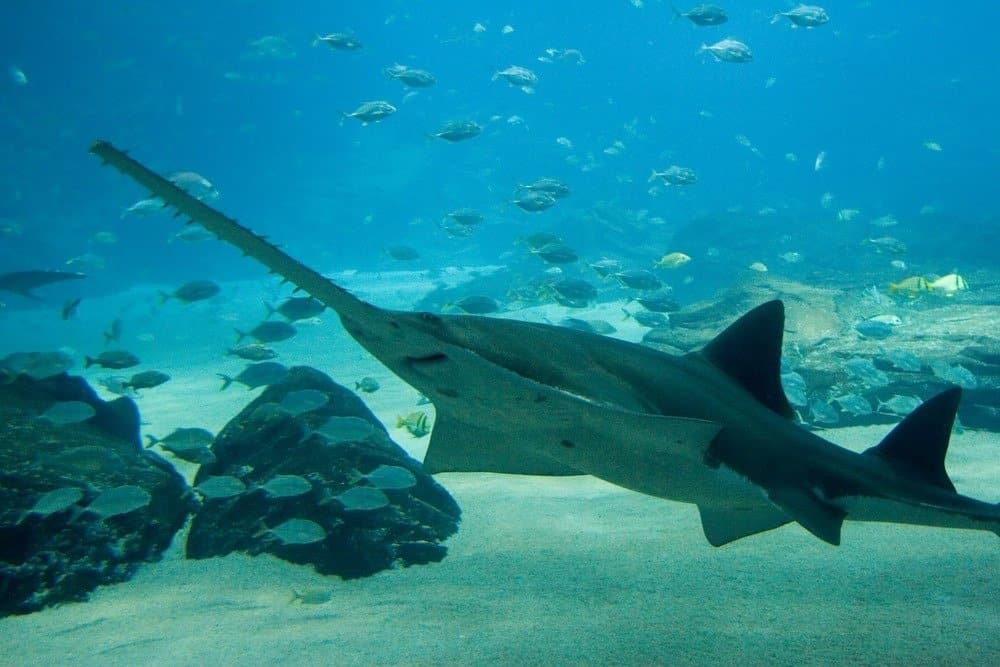Sawfish belong to the ray family and have large flat bodies with visible toothed saw on their faces. Another ocean-dwelling creature with a long “spear” on its head is the swordfish. Could these two sea creatures be related?
Stick with us as we explain several fascinating elements of sawfish vs. swordfish below.
Comparing Sawfish vs.Sawshark

| Sawfish | Swordfish | |
|---|---|---|
| Scientific Name | Pristis pectinata/Pristis perotteti | Xiphias gladius |
| Length | 18 – 25 feet | 10 – 14 feet |
| Weight | Up to 700 pounds | 1,430 pounds |
| Lifespan | 25 – 30 years | 10 – 16 years |
| Reproduction | 10 – 20 live young | Females can lay up to 29 million eggs |
| Range | Shallow, coastal waters. U.S., Mexico, Indian Ocean | Tropical waters of the Atlantic, Indian, and Pacific Oceans |
| Diet | Small fish and crustaceans | Bony fish and squid |
| Conservation Status | Endangered | Least concern |
The Primary Difference Between Swordfish and Sawfish
The primary difference between swordfish and sawfish is that sawfish are from the ray family and live on the bottoms of the sea while swordfish are bony fish that speed through the open sea.
Sawfish are bottom-dwelling fish, often burying themselves in the sand. The most notable feature of the sawfish is its flat bill extending from its beak. These beaks are also known as rostrums, but the more common term is a saw, which has teeth on either side. In contrast, the swordfish is more round-bodied than flat and has a visible sword-like bill extending from its beak.
This bill or sword is large and round and helps with the fish’s agility and speed. And rather than being a part of the ray family, swordfish is a species of bony fish. These fish live in all water bodies and often sun themselves on the water’s surface. Let’s dive into each difference in more detail below!
Sawfish vs. Swordfish: Size
Sawfish can very easily weigh up to 700 pounds. They are large fish and can grow to a length of 25 feet. Despite their size, they can only prey on small fish and crustaceans that they can fit in their mouths.
Swordfish can reach 14 feet. One specimen weighed 1,430 pounds. They are a popular game fish but aren’t known to attack humans.

Swordfish are not endangered and swim throughout the ocean’s waters. Sawfish are an endangered species due to overfishing and are mostly bottom-dwellers, living in shallow ocean waters, rivers, and lakes.
©Ariel Bravy/Shutterstock.com
Sawfish vs. Swordfish: Behaviour
Sawfish use delicate electric receptors on their saw to detect prey movement. This tool is handy for noticing prey in murky water or buried in the sand. Then, they use their saw to club prey before swallowing them.
Swordfish use their bill as a club to stun their prey. They also use their agility and speed as their primary hunting tool. Swordfish start out tiny, eating plankton, but end up as really big fish, eating bigger fish.
Sawfish vs Swordfish: Where Are They Found?

Sawfish belong to the ray family, grow to 25 feet and can weigh 700 pounds. Swordfish belong to the billfish family, reach 14 feet and can weigh 1.430 pounds. By adulthood, the swordfish loses all its teeth and scales.
©Stock High angle view/Shutterstock.com
Sawfish are bottom-dwelling, living in shallow coastal waters. They may also inhabit rivers and lakes and live primarily in tropical and subtropical areas. Sawfish were once a widespread species. But unfortunately, because of overfishing, they are now on conservation lists as a threatened species, at risk of dying out. And because they are so rare, you will now only find them in only two places in the world, Florida and North Australia.
Swordfish occupy the tropical waters of the Atlantic, Indian, and Pacific oceans. They frequent the water’s surface and deeper ocean parts. These fish are migratory, often traveling thousands of miles to get to warmer waters. Swordfish are also solitary and prefer to stay far away from each other, even when swimming together. Notably, they have a specialized tissue that helps warm their brains if they swim in deep cold waters.
Diet of Swordfish vs Sawfish
Sawfish will typically hunt for small fish and crustaceans. However, because of their protruding saws, they cannot tear at the flesh of their prey. Therefore, they only hunt small fish to fit in their mouths. When hunting, these fish use two tactics: one is to thrash their heads from side to side to stun potential prey. The other strategy is to use their saws to dig in the sand for prey.
Swordfish hunt fish and other prey by swimming after them and stunning them with their swords. Some experts think the swordfish may use their large sail-like fins to herd fish. However, the swordfish is also an opportunistic feeder, so it will consume any fish small enough. Typically, they swallow small fish whole and will slash or tear at bigger prey.

Like other ocean creatures such as the mako shark, swordfish use ocular heating for keen vision.
©SVITO-Time/Shutterstock.com
Reproduction
Sawfish give birth to live young. The female carries the fertilized and growing eggs in her belly until she is ready to birth them. However, not much is known about sawfish reproduction, but experts believe that females give birth to between 10 and 20 young. Also, unlike other fish, sawfish reach maturity at a later stage. Therefore, they don’t reproduce as frequently as other fish.
Swordfish reproduce by spawning. Spawning occurs when male swordfish release sperm into the water and females simultaneously release millions of eggs. Spawning times differ from area to area, so those living in temperate waters may spawn year-round. In contrast, those living in cooler waters may only spawn during the summer months.
Sawfish vs. Sawshark: Saws and Teeth
Sawfish have an extended rostrum featuring similarly sized teeth down both sides. The number and size of teeth vary between species but sawfish teeth grow from the bottom upwards Their teeth are also permanent, so if they lose any, they won’t grow back. Also, sawfish swish their rostrum backward and forwards through the sand to sharpen their teeth.
Swordfish have a long sword or bill, which can grow to a third of their body length. Unfortunately, bills do not grow back if broken off. However, the bill helps the swordfish swim faster, allowing them to escape predators, but it isn’t needed to survive. Unfortunately, swordfish bills are popular for use as art pieces.
Conservation Status
Sawfish comprises five species. They are all listed as critically endangered or endangered by the IUCN. Sawfish also face habitat losses because of human activities. People hunt these fish for their fins to make fin soup.
In addition, some people use their teeth and saws in traditional medicine and other parts. Since 2007, CITES has restricted international trade in sawfish and their body parts. Sawfish are protected in several countries, and perpetrators face hefty fines if caught hunting and catching these fish.
Although sawfish and swordfish are very popular game fish, the swordfish is valuable because of its swiftness and fighting spirit. And because of these characteristics, commercial and recreational fishers find them lucrative and challenging. Because of their money-making appeal, they establish fisheries wherever they can find swordfish.
Because these fish are abundant in the oceans, the IUCN Red List considers them the “least concern” in terms of dying out. And, swordfish stocks are reasonably well managed in most areas, ensuring they maintain their numbers. However, the biggest threat to swordfish remains fishing and other human activities.
The photo featured at the top of this post is ©
Thank you for reading! Have some feedback for us? Contact the AZ Animals editorial team.






